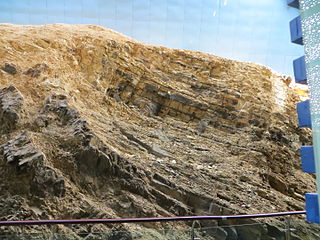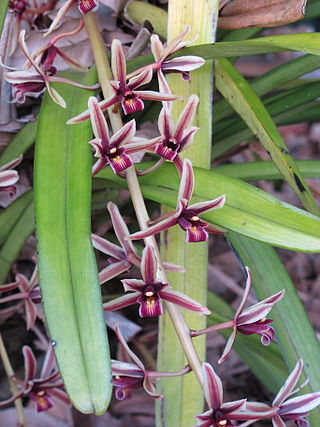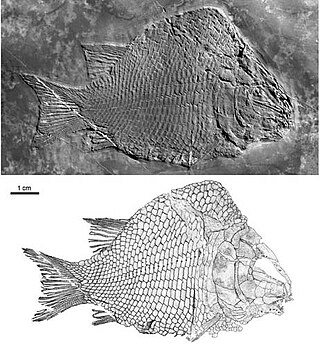
The Maotianshan Shales (帽天山页岩) are a series of Early Cambrian sedimentary deposits in the Chiungchussu Formation, famous for their Konservat Lagerstätten, deposits known for the exceptional preservation of fossilized organisms or traces. The Maotianshan Shales form one of some forty Cambrian fossil locations worldwide exhibiting exquisite preservation of rarely preserved, non-mineralized soft tissue, comparable to the fossils of the Burgess Shale of British Columbia, Canada. They take their name from Maotianshan Hill in Chengjiang County, Yunnan Province, China.

Acrossocheilus is a genus of ray-finned fishes in the family Cyprinidae, native to freshwater in China, Taiwan, Laos, and Vietnam. They are fairly small, no more than 30 cm (1 ft) in standard length.

The Cymbidieae is a tribe of plants within the family Orchidaceae. The group is divided into the following subtribes:
Sinocyclocheilus is a genus of freshwater fish in the family Cyprinidae that is endemic to Guangxi, Guizhou and Yunnan in China. Almost all of its species live in or around caves and most of these have adaptions typical of cavefish such as a lack of scales, lack of pigmentation and reduced eyes. Several species have an unusual hunchbacked appearance and some of the cave-dwellers have a "horn" on the back, the function of which is unclear. In contrast, the Sinocyclocheilus species that live aboveground, as well as a few found underground, show no clear cavefish adaptions. They are relatively small fish reaching up to 23 cm (9.1 in) in length. The individual species have small ranges and populations, leading to the status of most of the evaluated species as threatened. Many species populations in the genus have yet to be evaluated by the IUCN.
Oreonectes is a genus of fish in the family Nemacheilidae found in the rivers and caves of Asia. Many of these species are troglobitic.
Protocobitis is a genus of loaches endemic to Guangxi in China and living in caves.

Triplophysa is a genus of fish in the family Nemacheilidae found mainly in and around the Qinghai-Tibet Plateau in China, as well as inland waters of the larger part of central Asia. They can be distinguished from other genera of Nemacheilidae by marked sexual dimorphism, including the development of nuptial tubercles on breeding males. Currently, the genus is a mixed assemblage of species. Some lineages have been identified and treated as subgenera, but as Wikipedia follows Fishbase for fish species all but Hedinichthys have been treated as subgenera in Wikipedia, although Kottelat in his revision of the loaches did recognise them as valid. FishBase, however, includes these in Triplophysa without specifying subgenera and treats the names given by Kottelat as synonyms.
Amblyceps is a genus of fish in the family Amblycipitidae. The genera Amblyceps and Liobagrus are sister group pair that is, in turn, sister to Xiurenbagrus. These species are easily distinguished by the presence of pinnate processes along with the median caudal-fin rays, a prominent cup-like skin flap above the base of the pectoral spine, and the adipose fin largely separate from the caudal fin. In most species the caudal fin is deeply forked; A. apangi and A. murraystuarti differ in having their caudal fin truncate. Amblyceps species may reach about 100 millimetres (3.94 in) SL.
Xiurenbagrus is a genus of torrent catfishes of the family Amblycipitidae. It includes three species.

Liobagrus is a genus of catfishes of the family Amblycipitidae. Liobagrus fishes are distributed in the Yangtze River basin, Taiwan, Japan, and the Korea Peninsula. The adipose fin of these fishes is a confluent with the caudal fin. The nostrils are far apart, unlike those found in Amblyceps. Most Liobagrus species grow to about 100 millimetres (3.94 in) SL.

Silurus is a genus of catfishes native to Europe and Asia.

The Tiaojishan Formation is a geological formation in Hebei and Liaoning, People's Republic of China, dating to the middle-late Jurassic period. It is known for its exceptionally preserved fossils, including those of plants, insects and vertebrates. It is made up mainly of pyroclastic rock interspersed with basic volcanic and sedimentary rocks. Previously, the Tiaojishan Formation was grouped together with the underlying Haifanggou Formation as a single "Lanqi Formation." The Tiaojishan Formation forms a key part of the Yanliao Biota assemblage, alongside the Haifanggou Formation.

Pegasus is a genus of seamoths found in coastal tropical marine waters. The name was taken from the winged horse Pegasus in Greek mythology. This horse was created with Medusa´s blood. The member species are distributed in the Indo-West Pacific Ocean waters around: Australia, Bahrain, China, India, Indonesia, Japan, Malaysia, Mozambique, Myanmar, the Philippines, Saudi Arabia, Singapore, Taiwan, Tanzania and Thailand.

Luoxiongichthys is an extinct genus of basal actinopterygian known from the lower Middle Triassic of Luoxiong Town, Luoping County of Yunnan Province, southwestern China.
Homatula is a genus of stone loaches endemic to China.

Kyphosichthys is an extinct genus of basal actinopterygian bony fish known from the lower Middle Triassic (Anisian) marine deposits in Luoping, eastern Yunnan Province, southwestern China. The species is the first known fossil record of highly deep-bodied ginglymodians.
Discogobio is a genus of cyprinid fish that are found in eastern Asia. So far the 16 species have only been identified from China and Vietnam wherein each species is endemic to the country in which it is found.
Metzia is a genus of cyprinid fish that is found in eastern Asia. The genus is named in honor of the American ichthyologist Charles William Metz of Stanford University.
Parasinilabeo is a genus of cyprinid fish endemic to China. There are currently six described species in this genus.

Troglonectes is a genus of troglobitic fish in the family Nemacheilidae, native to caves of Asia. Fishbase and other authorities place these species in the genus Oreonectes.










